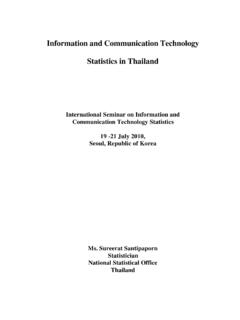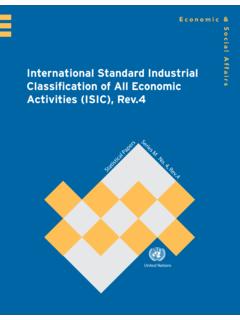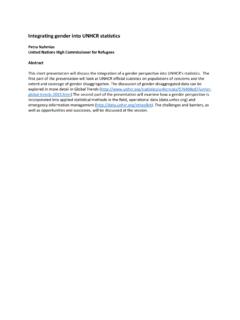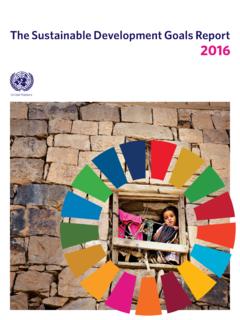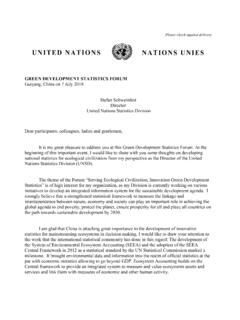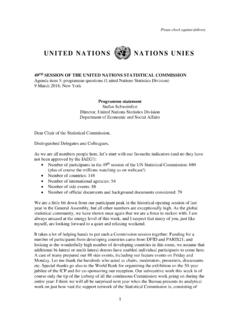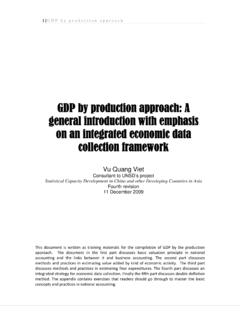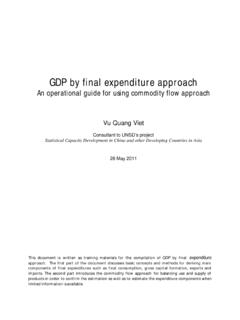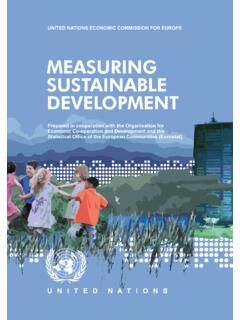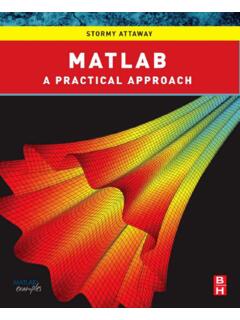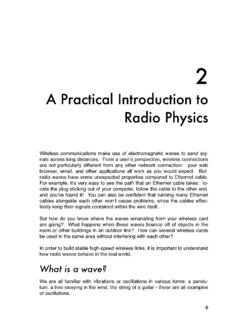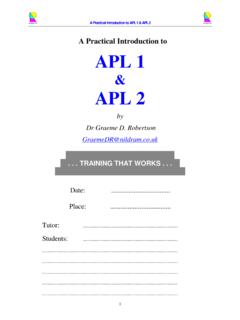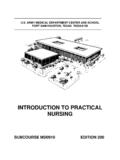Transcription of NATIONAL ACCOUNTS: A PRACTICAL INTRODUCTION
1 ST/ESA/ Department of Economic and Social Affairs Statistics Division Studies in Methods Series F, of NATIONAL AccountingNATIONAL ACCOUNTS: A PRACTICAL INTRODUCTIONU nited NationsNew York, 2003iiNOTE Symbols of United Nations documents are composed of capital letters combined with figures. The designations employed and the presentation of material in this publication do not imply the expression of any opinion whatsoever on the part of the Secretariat of the United Nations concerning the legal status of any country, territory, city or area or of its authorities, or concerning the delimitation of its frontiers or boundaries. Where the designation country or area appears, it covers countries, territories or areas. LIST OF ABBREVIATIONS Cost, insurance and freight CPC Central Product Classification (United Nations) CPI Consumer price index FISIM Financial intermediation services indirectly measured Free on board GCF Gross capital formation GDP Gross domestic products GFCF Gross fixed capital formation GNDI Gross NATIONAL disposable income GNI Gross NATIONAL income IC Intermediate consumption ISIC International Standard Industrial Classification of All Economic Activities NCS Net capital stock NFC Non-financial corporation NPISHs Non-profit institutions serving households PIM Perpetual inventory method PPI Producer price index ST/ESA/ Nations publication Sales No.
2 ISBNC opyright United Nations 2004 All rights reserved Printed in United Nations, New YorkiiiPrefaceNational Accounts: A PRACTICAL INTRODUCTION has been prepared as part of a series being developed by the member organizations of the Intersecretariat Working Group on NATIONAL Accounts (ISWGNA) to assist countries in the implementation of the System of NATIONAL Accounts, 1993(UnitedNations publication, Sales ). Its general objective is to provide an INTRODUCTION to some basic concepts and structures of the System of NATIONAL Accounts (SNA) to economists and policy makers who are not familiar with NATIONAL accounts, as well as other newcomers to the field of NATIONAL accounting. The text may serve as a guide to reading the SNA itself. In that sense, the text is written in as simple a style as possible, and therefore the detailed elaboration of concepts in both theory and practice is avoided.
3 Simple exercises are included, whenever possible, to make concepts and structures clearer to readers. The handbook also provides an example of the complete system in Excel so that readers can trace the linkages in the system by looking at the formulas there. A compilation spreadsheet that can be used for compiling NATIONAL accounts is also developed as part of the development of the handbook. It has been tested and used in many developing countries. Those supplements are posted on the web page of the United Nations Statistics Division as part of the series Handbook of NATIONAL Accounting. The text is not intended to replace either SNA or other handbooks. Compilers are expected to read the details in SNA as well as PRACTICAL applications and methods presented in the handbooks prepared either by the United Nations Statistics Division, the Organisation for Economic Cooperation and Development (OECD), The International Monetary Fund (IMF) or the Food and Agriculture Organization of the United Nations (FAO).
4 Many of those handbooks are posted on the web pages of the organizations that published them and can be obtained free of charge. The following handbooks have already been prepared or published: xHandbook on Non-profit Institutions in the System of NATIONAL Accounts (United Nations publication, Sales No. E. ) xUse of the System of NATIONAL Accounts in Economies in Transition (United Nations publication, Sales No. E. ) xHandbook of Input-Output Table Compilation and Analysis (United Nations publication, Sales No. ) xHousehold Accounting: Experience in Concepts and Compilation (United Nations publication, Sales No. , and 2) xLinks between Business Accounting and NATIONAL Accounting (United Nations publication, Sales )xA System Approach to NATIONAL Accounts Compilation (United Nations publication, Sales )xUse of Macro Accounts in Policy Analysis (United Nations publication, Sales, No.)
5 XTourism Satellite account : Recommended Methodological Framework (United Nations publication, Sales No. ) xBalance of Payments Manual (IMF, 1993) xBalance of Payments Compilation Guide (IMF, 1994) xGovernment Finance Statistics Manual (IMF, 2001) xA System of Economic Accounts for Food and Agriculture (FAO, 1996) xIntegrated Environmental and Economic Accounting (United Nations publication, Sales No. ) xHandbook on Quarterly NATIONAL Accounts, (Statistical Office of the European Communities (Eurostat) 1999) ivxQuarterly NATIONAL Accounts Statistics: Concepts, Data Sources and Compilation (IMF, 2001) xHandbook on Measurement of the Non-Observed Economy (OECD, 2002) xMeasuring Capital: A Manual on the Measurement of Capital Stocks, Consumption of Fixed Capital and Capital Services (OECD, 2001) xHandbook on Price and Volume Measures in NATIONAL Accounts (Eurostat, 2001) The present handbook was prepared by Vu Quang Viet of the United Nations Statistics Division.
6 Throughout the drafting of the handbook, valuable comments were provided by many experts in the field, particularly Cristina Hannig, Ivo Havinga, Karoly Kovacs, Mathias Reister and Mary Chamie of the United Nations Statistics Division, Brian Newson of Eurostat, Heidi Arboleda of the Economic and Social Commission for Asia and the Pacific, Estrella V. Dommingo of the NATIONAL Statistical Coordinating Board of the Philippines and Yatimah bt. Sarjiman of the Department of Statistics of Malaysia. Ms. Arboleda provided a number of exercises for incorporation in the handbook. Mathias Reister reviewed the draft carefully, providing important inputs to the rewriting of many chapters. The compilation worksheets were the result of the work over many years of Jan van Tongeren, Stefan Schweinfest and Vu Quang Viet, all of the United Nations Statistics Division.
7 The following are the web page addresses of various relevant international organizations and bodies: xUnited Nations Statistics Division: Monetary Fund: for Economic Cooperation and Development: Bank: and Agriculture Organization of the United Nations: Office of the European Communities: INTRODUCTION ..1 Part I: Accounts of the nationChapter 1: Chapter 2: Production account and goods and services A. Objectives ..16 B. Basic concepts and relations of goofs and services in NATIONAL domestic product (GDP) and value added ..16 and uses of goods and services ..17 relationships in NATIONAL approaches of calculating GDP .. of value added ..19 C. Production boundary and principles of valuation ..20 boundary ..20 of goods and services in the of NATIONAL accounts Basic definitions of other aggregates of goods and services in NATIONAL of output ..23 of intermediate consumption .. of final consumption.
8 25 of exports and imports of goods and services ..26 of gross capital formation ..27 E. Measurement issues ..30 of market output from sales ..30 output ..31 of wholesale and retail of financial intermediation services .. of intermediate consumption from purchase of materials ..33 of output by production of consumption of fixed capital .. between consumption of fixed capital, net capital formation, net saving and net value added .. 36 Exercise on GDP by production and final expenditure ..37 Chapter 3: Income account of the nation ..43 A. Objectives ..43 B. Important income concepts ..43 C. Primary income ..43 D. Gross NATIONAL E. Current F. Gross NATIONAL disposable income ..45 G. Relation between income of institutional sectors and the total Exercise on gross NATIONAL income, gross NATIONAL disposable income and gross saving ..50 Chapter 4: Capital account of the nation.
9 52 A. B. Investment in non-financial assets and sources of 54viC. Gross saving ..54 Chapter 5: Financial account of the nation A. B. Definition of assets and liabilities ..56 C. Relation with capital account ..56 Exercise on classification of transactions ..58 Chapter 6: Rest of the world A. B. Transactions with the rest of the world ..60 C. Balances in the rest of the world D. Relation between trade statistics and trade Chapter 7: Balance sheet of the nation ..63 A. B. Components of balance sheet ..63 C. Net Chapter 8: SNA framework for the total economy ..65 Exercise on setting up a full system of accounts of the nation ..69 Solutions:..71 Part II: Integrated accounts by industries and institutional sectors Chapter 9: Industry and sector breakdown ..74 A. B. What is an industry/establishment? ..74 C. What is an institutional unit?..75 D. Ancillary corporations/industries.
10 75 E. Institutional sectors in the economy ..75 F. An example for the need of both industry and institution G. H. Household sector ..77 institutions (NPIs) and non-profit institutions serving households (NPISHs)..78 government K. What should be excluded from general government sector?..78 Exercise on accounts of the government Chapter 10: Supply and use tables: integration of industry, products and sectors ..84 A. Objectives of supply and use tables (SUT) ..84 B. Organization of SUT ..84 C. Balancing SUT ..85 D. Breakdown of final uses ..86 E. Sectorization of value added ..87 F. Data requirement for sectorization of Exercise on setting up the supply and the use tables ..88 Solution ..89 Chapter 11: Institutional sector A. B. Types of income ..90 viiC. Sectoral balance of primary income ..90 D. Sectoral entrepreneurial income ..91 E. Sectoral disposable income.
